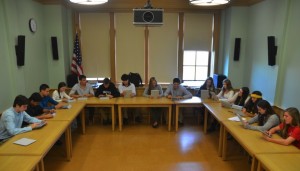
Students no longer use their laptops solely for taking notes or doing homework since teachers’ creative use of technology in the classroom has helped further and benefit classroom participation, organization, and student responsibility.
The English Department hopes to move towards a one-to-one student to device ratio. English Department Chair Richard Robinson believes that the one to one ratio will “exploit the teachable moment,” he said.
English teacher Raegan Russell uses the iPads in conjunction with her Keynote presentations through an app called NearPod; Dr. Russell uploads a presentation to NearPod, which allows students to use their own laptop or iPad to look at the presentation and zoom in on certain images. “Now the student sitting in the back of the room can see the details and zoom in when I tell them to look at the bottom left corner of a painting,” Dr. Russell said. This personal electronic copy of the presentation helps further discussion because students can focus less on trying to read the slides and focus more on participating. The electronic copy also allows for students to take notes on the key analytical points rather than the context on the slide, since the student will continue to have access to the slide.
Senior Corinne Alini carries her laptop to school everyday and found she prefers taking notes on her laptop. “For my history class, I thought it would be easier to have the notes typed up to study for the test,” Corinne said. “I can type faster than I write and can pick up more of what the teacher’s saying.”
Mr. McLay believes that iPads could also serve as a dual function as both a notebook and a student lab notebook. The tools essential to lab notebooks, such as graph paper and
tables, can be found on the iPad. “You can snap a picture and insert it. All the functions are on the same device,” Mr. McLay said.
Minimizing both the number of materials needed and the different locations of materials will help keep students more organized. Dr. Robinson agreed, “It’s harder for students to lose materials when they can be easily kept together.”
Freshman Matthew Bonanno likes to use his laptop to organize his notes and written assessments. “My laptop helps with my organization and I always know where everything is. I almost never lose anything,” he said.
Teachers are also looking to revolutionize the use of technology for students at home. Math Department Chair Diane Kaplan hopes to create a “flipped classroom” where students watch video lectures at home and try problems in class. “Technology makes me rethink things and how I can present them,” Ms. Kaplan said.
Matthew, who uses the inverted classroom for physics, thinks that the video works best for simpler topics. “Sometimes it’s nice to ask a question right away in class when you don’t understand something,” he said. “Not all students learn the same either, so it’s helpful in class when you ask a question and the teacher explains it a different way. You can’t do that with a video.”
However, watching lectures and lesson plans for homework will enrich student problem solving skills beyond traditional word problems or reading questions. For complicated topics, students will have to make creative questions to ask their teacher, as well as attempt to answer their questions on their own.
While recognizing the value of technology, some teachers feel concerned about Hackley becoming a one-to-one school. History teacher Vladimir Klimenko believes that increased technology hinders student learning. “Advocates of more technology tend to overlook something fundamental: ramping the use of technology tends to reduce face-to-face personal interactions,” he said.
Mr. Klimenko does not see the need for Hackley to become a laptop or iPad school, as teachers already have laptops, projectors, and internet access. “Unfortunately, technology innovation has turned most of us into herd animals obsessed with keeping up with the latest gizmo,” Mr. Klimenko said. “Regardless of whether or not this would be wise to the long term.”
Also, Mr. Klimenko believes that students would start multitasking during class. “People would chat, check email, look up stories…it’s absolutely unavoidable and predictable. Teachers would face the unenviable task of having to police it or ignore it,” he said.
Corinne also took her own initiative in using technology in the classroom. “Once a friend missed one of the history classes and I was able to tape the whole lecture for her so she was able to hear everything,” Corinne said.
Dr. Russell hopes her students will become more confident using iPads to avoid what she calls the “Freak Out Factor” or the discomfort that students associate with iPads. “It’s important to use the iPads on a continuous basis so students will feel confident and comfortable clicking around until they find what they need,” she said.
Mr. McLay agrees that students need training for using iPads on a daily basis. “Younger generations have needed to become more versatile with technology,” Mr. McClay said. “Right now, students use iPads for social use than academic use and we need to retool students for the academic nature of the device.”
Similarly, Corinne believes that learning to use her laptop in class will help prepare her for college, as most college students take notes on their laptops.
Eliminating this “Freak Out Factor” and creating a comfort level with creative and innovative ideas the teachers plan to implement will be the final factor in fully maximizing individualized technology at Hackley.


